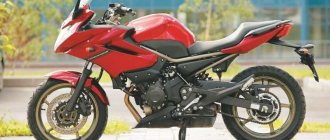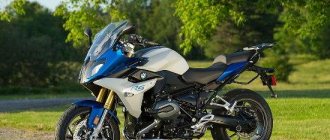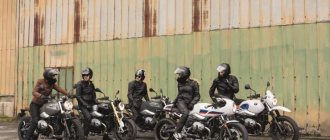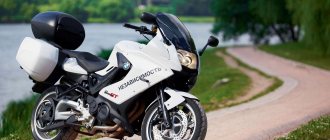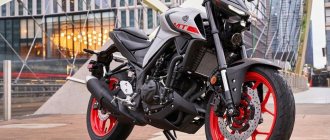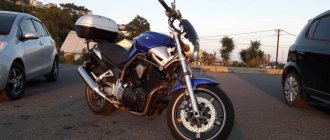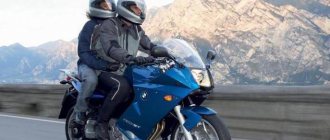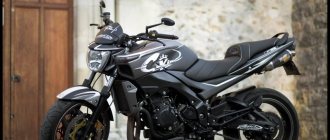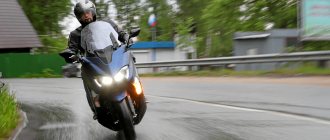The great success of the 600 cc diversion, introduced for export markets in the first half of the 90s, inspired the developers. In 1995, the series received an older brother - the Yamaha XJ 900 S Diversion. Model did not have a special appearance — the designers wanted to make a motorcycle for every day. Whether in the city or in the distance. The idea turned out to be successful. The bike turned out great convenient, “eternal” (when leaving), and according to the “second numbers”, quite broad.
The bike existed on the assembly line until 2002, on sale until 2004. In 2005, it became impossible to buy a new motorcycle - sabotage became history.
Bike features
Advantages of this motorcycle:
- relative versatility;
- not too high fuel consumption, approximately 6 liters per hundred;
- reliability and maintainability.
The model is convenient both in the city and beyond, thanks to the combination of maneuverability with good directional stability. The Yamaha XJ 900 S Diversion will not appeal to those who are picky about the exterior of the motorcycle, because the bike looks a little unsightly. However, everything is not so bad, and someone will find their beauty in this model.
Review of the Yamaha XJ 900 S Diversion motorcycle
So, sports tourist Imaha Diversion, 1996, 900 cubic meters, 92 horses, 250 kg weight filled with all liquids, 72,000 km of mileage on geyrops, cardan, air. I will write almost in the style of akyn - “What I see is what I sing”, in this case - “what I think right now is what I write.” Despite the underground nickname (which everyone knows), the motorcycle is very reliable and does not let you down. Yes, in general it suits me completely.
I will write almost in the style of akyn - “What I see is what I sing”, in this case - “what I think right now is what I write.” Despite the underground nickname (which everyone knows), the motorcycle is very reliable and does not let you down. Yes, in general it suits me completely.
Pros:
1. Engine. The power is just right, of course, when you’re driving up a hill with a load to overtake, you want more so you don’t have to switch from fifth to fourth, but these are minor things. When alone everything is fine. Again, the engine is almost a liter, eight-valve, with a thrust of almost 100 Nm, allowing even a loaded vehicle to drive 40 km/h in 5th gear and, if necessary, accelerate to 200 km/h! The engine doesn't choke, doesn't jerk, it just pulls and pulls! I like this elasticity, and with such a degree of boost, the resource should be incredible, which is actually confirmed by its mileage and excellent condition. At the top it also spins vigorously, it shoots from 5 to 8 thousand revolutions, just hold on. Yamaha made a successful engine. Although the mileage is already 79,000 km, at 6,000 km I consumed 200 grams of oil, and then in the section where I drove along the roads of the Rostov region at 160-170 km/h, the speed being 7000-7500 rpm. The consumption turned out to be 6l/100km on a trip to Crimea, which sounds like pennies to me. They brought me this motorcycle from Belgium with a mileage of 72,000 km, the engine started immediately from the first crank of the starter, warmed up and rustled barely audibly at idle. And in the future there were no complaints about it, you drive all day, stop in the evening and it rustles just as well at idle, as if you had just warmed it up. Well, I don’t know how to describe his work! And this crackling of the cylinder block as it cools down, it’s kind of touching and contented , like, well, I’ve had enough of it, returned home safe, and now I’ll sleep peacefully in the garage;
The power is just right, of course, when you’re driving up a hill with a load to overtake, you want more so you don’t have to switch from fifth to fourth, but these are minor things. When alone everything is fine. Again, the engine is almost a liter, eight-valve, with a thrust of almost 100 Nm, allowing even a loaded vehicle to drive 40 km/h in 5th gear and, if necessary, accelerate to 200 km/h! The engine doesn't choke, doesn't jerk, it just pulls and pulls! I like this elasticity, and with such a degree of boost, the resource should be incredible, which is actually confirmed by its mileage and excellent condition. At the top it also spins vigorously, it shoots from 5 to 8 thousand revolutions, just hold on. Yamaha made a successful engine. Although the mileage is already 79,000 km, at 6,000 km I consumed 200 grams of oil, and then in the section where I drove along the roads of the Rostov region at 160-170 km/h, the speed being 7000-7500 rpm. The consumption turned out to be 6l/100km on a trip to Crimea, which sounds like pennies to me. They brought me this motorcycle from Belgium with a mileage of 72,000 km, the engine started immediately from the first crank of the starter, warmed up and rustled barely audibly at idle. And in the future there were no complaints about it, you drive all day, stop in the evening and it rustles just as well at idle, as if you had just warmed it up. Well, I don’t know how to describe his work! And this crackling of the cylinder block as it cools down, it’s kind of touching and contented , like, well, I’ve had enough of it, returned home safe, and now I’ll sleep peacefully in the garage; sometimes I’ll just stand and listen to this crackling sound).
sometimes I’ll just stand and listen to this crackling sound).
2. Appearance. Of course, there’s not enough wow factor in it, Viraga was more impressive to friends, acquaintances and neighbors at the traffic lights, but I don’t care, in my opinion the design is moderately aggressive, moderately sporty. I like.
3. Cardan. No hassles for you with replacing and lubricating the chain and sprockets. Change the oil every two years and drive away.
4. Convenient layout of units, made for people. Changing the spark plugs is no problem; if you have a flexible key, you don’t even have to drop the tank. Air filter - drop tank for 2 minutes. Changing a light bulb is also no problem, you can climb up without any problems. There is a normal cavity under the seat, all the keys you need on the road fit, 0.5 oil in a plastic bottle and a few other small things.
5. Landing. You sit upright, like a person, on mine the Belgian also installed spacers under the steering wheel - what a beauty! I once had a CBR1000F, they write about it that it has a kind of comfortable seating position for a sports tourist - but I didn’t think so, 900 km a day on it was difficult for me, the load on my hands was good...
6. Overall reliability. Upon arrival, the spendthrift changed the oil and filter, pumped up the tires and blew out the air vent. That's all! Everything else was fine, although the front pads were on their way, there were 3-4 millimeters left, but that was enough for me for the season. On good terms, I should have pumped the brakes more for peace of mind, but somehow I didn’t get around to it. I drove to Crimea without any problems, there were no technical problems. There is no water cooling - also a plus for reliability. And with air it didn’t overheat even in Crimea, everything was fine with cooling 
7. Suspension. I don't have much to compare it to, but I like the suspension better than on my previous Honda CBR 1000F and Yamaha XV1100 Virago. It’s comfortable and the car steers well and drives normally with number two, you can hardly feel the passenger 
8. Strong plastic. Survived two falls at low speeds with almost no losses, no cracks, only abrasions. In general, the plastic of the muzzle inspires respect - it’s thick!
9. Undervalued. Motorcycles are quite cheap, you can buy a lot of motorcycles for little money. And given the large resource, this is one of the few models from the 90s that can still be bought in decent condition.
Now about the cons. Not that they are significant, but you can’t erase the words from the song 
1. Weight. You have to understand that 250kg is still no joke. While you are driving on the asphalt, you don’t feel the weight, but as soon as you turn onto the ground or, God forbid, get into the mud, you immediately understand what a behemoth is underneath you. In general, you don’t need to drive it off the asphalt, especially on road tires; its element is asphalt. Personally, the weight doesn’t bother me, I just don’t poke my nose where it shouldn’t and everything is fine. In the parking lot, it can also sometimes be a little difficult to squash it, but this is already a nice little thing :).
2. Wind protection. I wish there were more. You can, of course, buy a high windshield, but 4000 rubles for a piece of plastic - be on the lookout for a toad! I almost got out of the situation by attaching a plexiglass cap to my original windshield, but it turned out to be lower than necessary. I'll make it higher before next season, let's see what happens.
3. Brakes. With the second number and load, when the weight of the moto reaches the maximum allowed by the factory 480 kg, the brakes are no longer enough, you have to think in advance whether you will have time to brake or not. But again, you always have to think, and when you’re alone or just with the second number, everything is fine.
4. Tendency to stall when turning at low speeds. Because of this, I kissed myself once on a serpentine road in Crimea. The road went downhill and with a sharp right turn, I didn’t understand what happened, how I ended up on the asphalt, fortunately the speed was about 30 kilometers and the turtle boots and knee pads saved me. This is the downside of the fact that at speed the bike itself stands on an arc and easily shifts from side to side. I understand so. If anyone buys such a pepelats, take this point into account.
Yamaha sabotage '97 with a mileage of 12 thousand, bought new in the showroom. It comes with 3 awesomely large trunks with a total volume of 126 liters, all equipped with a body kit and goodies such as roll bars, signaling, xenon, etc. In addition, the old owner gave away a whole box of consumables/spare parts and all sorts of useful things))
So, first impressions. Before this, I only rode the super magna for a long time, so I’m comparing it with it. My height is 192, my weight is currently 75.
1. landing. Quite comfortable, the only thing that is not usual is that the legs are shifted somewhat back relative to the Magna, and even the Urals. It’s not very familiar, I’ll tell you, but it’s quite comfortable and does not cause discomfort. At first, however, I sometimes missed the steps without getting used to it and put my feet on the gear shift and the brake foot.
2. In my opinion, the steering wheel is quite narrow, but at the same time very comfortable, my hands do not become numb and do not hurt when driving straight and turning.
3. The tidy is quite informative, the only thing missing in my opinion is a charging indicator. And what’s unusual is that the oil light indicates insufficient level, not pressure.
4. Dynamics and speed. Well, everything is just awesome here, up to 100 mph I think the magna will not lose, but after that the sabotage will take over, 160 on the diversion is just like you stand, but on the magna I was less comfortable.
5. Brakes... Well, everything is just awesome here, it brakes like a stone, both in front and in back.
6. The passenger on the diversion feels simply amazing, today I rode with a friend in his height and weight more than me, behind his back he had a backpack with junk, there was a rear trunk, so after my question about convenience, he said that everything was great. In general, two not small people fit easily and without strain for both.
7. The fairing on the diversion is cool, the hands are perfectly protected from cold air flows, on the magnet the hands froze more severely, but the throat on the diversion is better ventilated. You drive more than 100 and for some reason the entire flow of air falls on your throat, it’s not pleasant, let me tell you. But it can be treated by wearing a sports suit jacket with a high collar under a biker jacket.
Added: so, I skated more than 4 times. The flight is normal. Doesn't eat butter. Fuel consumption (92) if you cut on the highway no more than 120, then 5 liters, but if you give it up to 160-180, then it increases to 6-6.5. I am 100% satisfied. Still, the only thing that bothers me is the air flow from the fairing, which blows straight into my neck. Something needs to be done about this, perhaps installing some other fairing. In general, I will experiment as much as possible.
What I really like is the availability of free space. Under the seat you can organize a mini-warehouse for useful items and tools. The ability to adjust the fork stiffness is a definite plus.
Exploitation:
1) Consumption 5.3 l/100 mixed. cycle
2) There are no costs for cleaning/lubricating/replacing/replacing sprockets (universal shaft). Even periodically tightening (as in the case of a chain) is also nothing to do.
3) Quite heavy. 240 kg dry weight. 24 liters of fuel, 4.5 liters of oil... But in reality there is nothing terrible about it. With a weight of 85 and a height of 178, I don’t experience any problems.
4) Rubber (Dunlop Spotmax) is worn out by ~30% after 5000 km.
5) There was no notice of oil consumption (Motul 7100).
6) Oil/air filters (original) 540/1050 rub. respectively (Existential).
7) Brake pads average from 1200 to 1800 per pair. Total “per round” ~4500 rub.
The seating position is very comfortable, almost straight. It doesn't blow. The same applies to the passenger. Convenient for everyone. The long road will not be a burden.
Dynamics - well, according to tradition: “doesn’t work.” Let’s just say that when you sit on a 400k you don’t understand what’s going on at all and whether it’s a moped or a moped... When you sit on, say, a Z750 you understand that Diversion is really a vegetable. In general, everything is learned by comparison. Who cares...
6th gear is really “missing”. Because of this, the cruising speed is ~140 km/h. This is about 6,000 rpm in 5th. It goes on easily, but IMHO for an engine with a maximum rpm. power of 8250 rpm (judging by the numbers on the Internet), driving “higher” for a long time is not a good idea. On the tachometer, the redline is from 9,500, in fact it spins easily up to 9,000, but even this doesn’t make much sense, it feels like there’s a fairly even shelf of torque in the range of 4000-7000, then it fades and after 8000 it drops very noticeably. “From below” from 2500 it’s already driving quite confidently.
Despite the fact that Yamaha positions it as a sport-tourist, IMHO the word sport is clearly superfluous here. Tourist online. Like a real “truck,” it boldly carries 2 side cases of 30 liters each and a central one of 40 liters (I can’t say for sure, the sticker inside the case has worn off). At the same time, it doesn’t look ridiculous. Because that’s what he’s “supposed to do.”
Air balloon. On the road you will not have a headache with a leaking radiator of the cooling system, etc. The main principle when creating is simplicity of design throughout. 8 valves (2 per cylinder), adjustable with washers, but does not require dismantling the camshafts. The cardan drive does not require periodic maintenance (except for oil changes every 24,000 km), which is very convenient on a long journey and does not force you to carry chain wash/lubricant with you.
The flow does not arouse interest from traffic police officers. Apparently because neither young people without licenses, nor “real racers”, nor gloomy guys in leather jackets usually ride these cars...
Well, if it’s quick, that’s all...
Dimensions and weight
The seat height – 795 mm – makes the model accessible to most motorcyclists. The 1505mm wheelbase is not too long for such a hefty bike, as the XJ 900 S Diversion has a curb weight of 265kg. The gas tank here is impressive: as much as 22 liters, which makes the car a good choice for tourists.
Flaws
- Weight . Large weight gives an advantage on the road, but not with this bike. A slight bump or pothole and he will try to jump out from under the rider. A trip to grandma’s in the village - only in dry weather and only on asphalt.
- Wind protection . It’s normal for the city, but at high speed it may not be enough for a tall motorcyclist.
- The suspension is very soft for such a colossus . With a load and number two, licking every bump on the road is guaranteed.
and dignity
- Good and strong plastic.
- Reliability.
- Unpretentiousness.
- Comfortable fit.
- Although it fits tightly, it does not require disassembly to the base for maintenance.
- The cardan does not require as frequent maintenance as a chain drive.
Chassis and brakes
Comfortable soft suspensions are perfect for long journeys. They are able to smooth out asphalt unevenness to a certain extent. But don’t forget that the XJ 900 S Diversion is still a road bike, not an off-road motorcycle. It is also better to remember that this model does not like sharp turns.
The bike has three disc brakes that work well, although not perfectly. The alloy wheels are quite typical and nondescript. The tubular frame is made of steel. The motorcycle may appeal to fans of old equipment from the nineties.
For whom is it intended?
Export production meant a tall European. But thanks to special developments, a person of any height could buy this bike.
Thanks to the good fit and comfortable sitting on this motorcycle, you feel at home.
Both a tall and tall biker and his short colleague could simply stand with their feet on the ground.
Modifications
Initially, no special modifications to the model were planned.
, the XJ 900P - Police version soon appeared .
The engine from the racing R1, special tires and gearbox settings distinguished this version. But it did not go on general sale.

